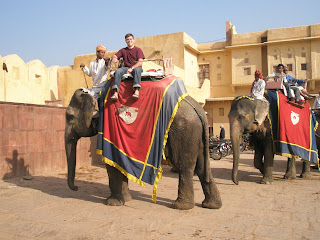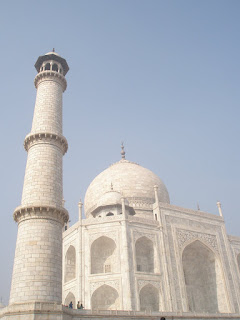
Today we went to the Taj Mahal. It would be worth the whole trip to India just to visit the Taj. It's that incredible. The experience of being there is sublime, like being in a dream. There really isn't anything that I could say to prepare you for it. And the pix don't even come close to doing it justice.
The Taj is in Agra, which is about a 3-4 hour drive (200 km) from Delhi. Agra was the capital of the Mughal empire, which was at its peak in the 17th century. Taj Mahal means 'Crown Palace' and it was built by the emperor Shah Jahan for his wife Mumtaz who died at the age of 39. Supposedly, before she died, she asked Shah Jahan to do two things. First, build her a beautiful tomb, and second, never remarry. Both of these things, he did, however, the remarriage bit is a bit tricky as he lived with a harem of 300 women in Agra fort...more on that later.
The Taj Mahal is constructed of Agra white marble which is an incredible material. Stronger and more durable than Italian marble, it does not stain, discolor or erode. It is crystalline in structure. The tomb is obsessively symmetric. All of the inlays, bas-reliefs, and other sculpted items, along with the buildings and architecture themselves are exactly symmetric about the tomb of Mumtaz. The ONLY asymmetric item is the tomb of Shah Jahan himself which was added after he died and in a way highlights the fact that the tomb is there for his wife, and he is an outsider.

When you visit the taj, you cannot see it until you walk through the gate, because the walls around the gardens are high enough that they obscure it from view. It is striking to get the first glimpse of it through the portal as if in a picture frame.

The facade of the Taj is inlaid with semiprecious stones that reflect the light of the sun like a mirror. When you are standing right in front of it, it is physically hot because of the intensity of the reflections. This is despite the fact that the temperature in Agra is actually quite cool (less than 20 C...as you can see we are wearing fleece...) Here's a shot of the inlay reflections:

The islamic tradition does not allow for representation of human or animal forms in its architecture. Therefore, all of the decorations are either geometric (mostly herringbone and spiral), calligraphic (inscriptions from the Qu'ran), or vegetative (plants, particularly lotuses, roses, irises, and lilies). The craftsmanship is incredible. It took 20,000 skilled craftsmen 22 years to construct the Taj. Over 400,000 man-hours worth of work went into the building. Incredible.



Okay we are about to leave and I have to stop. But there's more stuff I want to tell you about the Taj I will just have to wait and continue that later tonight.











 One interesting thing about the mosque complex at Qutub Minar is that it was built on ground that was previously occupied by 27 Hindu temples. However, the incoming muslim ruler wanted these temples destroyed and had a mosque and victory tower built on top of them to symbolize islamic dominance over the indigenous hindu peolpe. The mosque was built from the pieces of the destroyed hindu temples. However, one interesting feature is that, although islam forbids the use of animal or human sculpture in holy architecture, hinduism sees animals as sacred and so includes many kinds of human and animal sculpture in its temples. The hindu builders of the new mosque were aware of this and featured bits of human and animal sculpture prominently in the new mosque's construction, thereby thwarting the invader's wishes and preserving their impact on the mosque. By the time the overseers of the work realized the faux pas that was being committed, it was too late and the pieces were already in place. Therefore, they decided to cover up the ornamental sculpture with plaster so that it would be plain. This worked fine when the mosque was new. However, after 9 centuries of wear, most of the plaster is gone and now the original sculpture shows through. I think it's a beautiful and poetically just thing to see the original hindu craftsmanship show through after all this time.
One interesting thing about the mosque complex at Qutub Minar is that it was built on ground that was previously occupied by 27 Hindu temples. However, the incoming muslim ruler wanted these temples destroyed and had a mosque and victory tower built on top of them to symbolize islamic dominance over the indigenous hindu peolpe. The mosque was built from the pieces of the destroyed hindu temples. However, one interesting feature is that, although islam forbids the use of animal or human sculpture in holy architecture, hinduism sees animals as sacred and so includes many kinds of human and animal sculpture in its temples. The hindu builders of the new mosque were aware of this and featured bits of human and animal sculpture prominently in the new mosque's construction, thereby thwarting the invader's wishes and preserving their impact on the mosque. By the time the overseers of the work realized the faux pas that was being committed, it was too late and the pieces were already in place. Therefore, they decided to cover up the ornamental sculpture with plaster so that it would be plain. This worked fine when the mosque was new. However, after 9 centuries of wear, most of the plaster is gone and now the original sculpture shows through. I think it's a beautiful and poetically just thing to see the original hindu craftsmanship show through after all this time.
















 This is me, Joe, and Hannah on the path leading into the fort. You can see the drawbridge & gate behind us. The bridge goes over the moat.
This is me, Joe, and Hannah on the path leading into the fort. You can see the drawbridge & gate behind us. The bridge goes over the moat. This is a view of the water moat.
This is a view of the water moat. Ramp leading into the fort proper. You can see the drains/hot oil channels on the sides of the ramparts.
Ramp leading into the fort proper. You can see the drains/hot oil channels on the sides of the ramparts. Our guide Ranna explains about the hollow walls replacing microphones in the audience hall.
Our guide Ranna explains about the hollow walls replacing microphones in the audience hall.
 The Harem. Fountain in the foreground.
The Harem. Fountain in the foreground. 






 When you visit the taj, you cannot see it until you walk through the gate, because the walls around the gardens are high enough that they obscure it from view. It is striking to get the first glimpse of it through the portal as if in a picture frame.
When you visit the taj, you cannot see it until you walk through the gate, because the walls around the gardens are high enough that they obscure it from view. It is striking to get the first glimpse of it through the portal as if in a picture frame. 
 The islamic tradition does not allow for representation of human or animal forms in its architecture. Therefore, all of the decorations are either geometric (mostly herringbone and spiral), calligraphic (inscriptions from the Qu'ran), or vegetative (plants, particularly lotuses, roses, irises, and lilies). The craftsmanship is incredible. It took 20,000 skilled craftsmen 22 years to construct the Taj. Over 400,000 man-hours worth of work went into the building. Incredible.
The islamic tradition does not allow for representation of human or animal forms in its architecture. Therefore, all of the decorations are either geometric (mostly herringbone and spiral), calligraphic (inscriptions from the Qu'ran), or vegetative (plants, particularly lotuses, roses, irises, and lilies). The craftsmanship is incredible. It took 20,000 skilled craftsmen 22 years to construct the Taj. Over 400,000 man-hours worth of work went into the building. Incredible. 

 Okay we are about to leave and I have to stop. But there's more stuff I want to tell you about the Taj I will just have to wait and continue that later tonight.
Okay we are about to leave and I have to stop. But there's more stuff I want to tell you about the Taj I will just have to wait and continue that later tonight.
 Okay I know I said it would just be one, but this one is also really good:
Okay I know I said it would just be one, but this one is also really good: